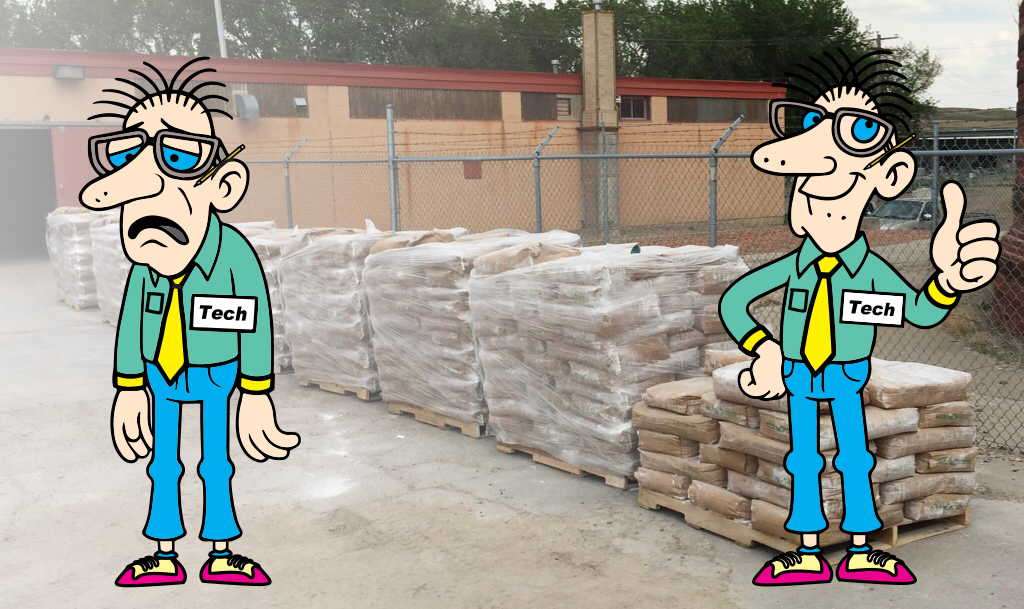| Monthly Tech-Tip | No tracking! No ads! | |
WSR - Wet Sieve Residue Test
A simple test of making a visual observation of how much residue, typically from a 50 or 100 gram powder sample, remains on a testing sieve after washing through a slurry of the material. This is almost always done as a quick way to assess material quality in comparison with past lots or shipments (e.g. of feldspars, kaolins, ball clays and silica), that is why a washing test is far more suitable (results are reproducable and it would be impossible to conduct a dry test at the fine sieve sizes needed). Since this test is normally done on many samples (e.g. from each pallet of a shipment), the technician simply makes a judgement call by comparing the amounts left on the wet sieve after washing, with the historically normal amounts.
Oversize Particles Simple Test

This picture has its own page with more detail, click here to see it.
This is simple test can be done to determine if oversize particles are present in a raw material to be used for clay body manufacture. While materials are sold as minus 200 mesh, as you can see here, they don't even pass at 150 mesh. In each case, we have attempted to wash through 50 grams of the powder (using the technique of our WSR test).
All ceramic materials must be ground using particle size reduction equipment. This process enables removal of contaminants or reducing their size enough that they do not marr the fired surface of the body. This is a demanding task. Being able to measure it quickly enables spotting problems with a materials shipment (and therefore how well a supplier meets their quality obligations and the kind of product that can be made using it). Ball clays and kaolins are the most problematic, not just in particle size and contaminating particles but also fired color and plasticity.
Of course, a record of this needs to be kept. That is where your account at Insight-live.com comes in. Upload pictures like these or just make a note of the result.
20 Skids of Material Just arrived
Fatique Freddie is overwhelmed!

This picture has its own page with more detail, click here to see it.
He is the lone quality technician, part time. Incoming materials properties keep changing, but management pretends they aren't. Freddie is tired of dealing with what could be lurking in these pallets—grit and fired specks, drying cracks, warping, blistering - he's flying blind. It’s just a matter of time before something fails… and his name is on it! But there is a way to start "owning the problem" by starting QC small (using Insight-live):
-Number the pallets with a big marker.
-Add a new record in Insight-live, assign a new code number and date and link it to a specification.
-In the notes, log lot numbers from the bags and any pertinent details (e.g. supplier invoice, PO#).
-Upload supplier certificate photos.
-Grab samples through the bag spouts— one per lot or pallet.
-Do testing for oversize particles (especially in clays).
-Make SHAB test bars (for clays). Dry them in a dehydrator and fire them overnight (because production wants to start using this tomorrow!).
-Snap close-up photos of the fired bars and upload and annotate them for future comparison.
This is survivable QC. It won’t fix everything. Now he is Ready-Freddie, with a solid plan to stand on when the blame starts flying. Maybe he will even be able to establish coordination between sales, production, and QC (using a group account) and even refine the specifications and procedures for each material type.
Oversize particles in a typical manufactured porcelain body

This picture has its own page with more detail, click here to see it.
Example of the oversize particles from a 100 gram wet sieve analysis test of a powdered sample of a porcelain body made from North American refined materials. Although these materials are sold as 200 mesh, that designation does not mean that there are no particles coarser than 200 mesh. Here, there are significant numbers of particles on the 100 and even 70 mesh screens. These contain some darker particles that could produce fired specks (if they are iron and not lignite); thank goodness in this case they do not. Oversize particlate is a fact of life in bodies made from refined materials and used by potters and hobbyists. Industrial manufacturers (e.g. tile, tableware, sanitaryware) commonly process the materials further, slurrying them and screening or ball milling; this is done to guarantee defect-free glazed surfaces.
Watch out for iron particles in ball clays

This picture has its own page with more detail, click here to see it.
These are the oversize particles (from the 70, 100, 140 and 200 mesh sieves) from 100 grams of a commercial ball clay. They have been fired to cone 10 reduction. As you can see, this material is a potential cause of specking, especially in porcelain bodies. It is not only wise to check for oversize particles in clays, but firing these particles will reveaal if they contain iron. A 200 mesh screen would be a good start for this test, it would catch all of these.
This is what labs use to measure particle size

This picture has its own page with more detail, click here to see it.
To measure particle size in a slurry or powder you need sieves. This is the most popular type used in labs. They are made from brass by a company named Tyler. The range of screen sizes for testing particle size is very wide (obvious here: the top screen has an opening of 56 mm, the bottom one 0.1 mm - the wires are almost too small to see). You can often buy these used on Ebay for a lot less than new ones, search for "tyler sieve". The finer sieves (especially 200) are fragile and more easily ripped. For potters it is good to have a 50, 100 and 150.
Variables
VAL - Value (V)
Describe residue
Related Information
Videos
Links
| Tests |
% Passing 325 Mesh Wet
The amount of particulate material left on a 325 mesh sieve after washing through a measured amount of the powder. |
| Tests |
Hegman Fineness
|
| Tests |
LOI/Density/Water Content
LDW LOI, density and water content test procedure for plastic clay bodies and porcelains |
| Tests |
Sieve Analysis 35-325 Wet
A measure of particle size distribution by washing a powdered or slaked sample through a series of successively finer sieves |
| Typecodes |
Particle Tests
Tests conducted to determine particle populations, sizes, shapes, densities, surface areas, etc. |
| Glossary |
Sieve
Sieves are important in ceramics for removing particulates and agglomerates from glaze, engobe and body slurries. |
| By Tony Hansen Follow me on        |  |
Got a Question?
Buy me a coffee and we can talk

https://digitalfire.com, All Rights Reserved
Privacy Policy
